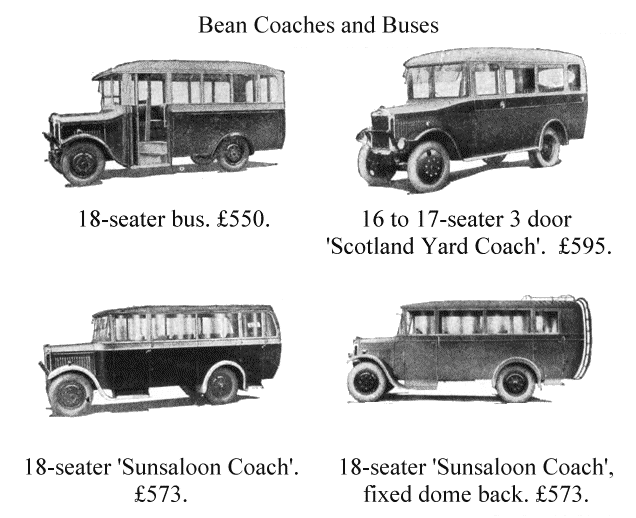|
Background
It all started when Absolom
Harper and his two sons founded A. Harper & Sons,
ironfounders, at Waddams Pool Works in Hall Street,
Dudley. In 1907 the name was changed to A. Harper,
Sons & Bean in 1907 when principal shareholder
George Bean became chairman. The business greatly
prospered during the First World War thanks to a
plentiful supply of ministry contracts for
munitions. After the war George Bean received a
knighthood for his services to the war effort, and
his only son John, known as Jack, who also worked in
the business, was made a CBE. |

|
The
Bean Car
At the end of hostilities the
lucrative munitions orders ceased and something had to
be quickly found to replace them, so that the business
could survive. At the time motor cars were becoming
increasingly popular, and so the decision was taken for
the company to become a car manufacturer. In January
1919 the company purchased the jigs, patterns, tools,
and manufacturing rights for the Perry car, and
production soon got underway. The company’s first car,
the Bean 11.9, a slightly updated Perry design, was
launched at the 1919 Motor Show, but sales were not
good, because the selling price was a little on the high
side. Although prices were slashed, the recession in the
car industry in 1920 rapidly led to spiralling debts. A
receiver was appointed, and production ended at Tipton
in October 1920. In November Jack Bean resigned from the
company.
During November 1921 a huge
investment of capital by Sir George Bean, Barclays Bank,
The National Provincial Bank, and Hadfields enabled them
to buy a 55% controlling interest from Harper Bean and
repay the creditors. This allowed A. Harper, Sons & Bean
to manage their own affairs again, but would have
serious financial implications five years later. Car
production started again in 1922, and slowly increased
to 100 cars a week by August. October 1923 saw the
launch of a new car, the much larger Bean 14, powered by
a 13.9 hp. engine, and fitted with a 4-speed gearbox.
The engine and gearbox would prove to be ideal for the
company's first commercial vehicles. |

The Tipton factory in 1925.
|
Bean Commercial vehicles
During the six and a half years of
commercial vehicle production at Beans, many small
single-decker buses and coaches were produced on the
company's standard range of chassis.
In November 1924 the company
launched the first Bean commercial vehicle, a 25 cwt.
chassis based on the 14.9 hp. engine and gearbox. The
vehicles mainly appeared as lorries, but vans,
ambulances, coaches and light buses were also made. The engine and gearbox were mounted
on a separate chassis, and initially, the vehicle only
had rear wheel brakes. The 20/25 cwt. chassis sold for
£265. From 1926 front wheel brakes were available for an
extra £20.
Unfortunately Bean suffered
from an acute shortage of cash, with debts totalling
£1.8 million, mainly due to the restructuring in
November 1921. As a result Hadfields, the Sheffield
steel producer, rescued the company and renamed it Bean
Cars Limited, in June 1926.

In June 1927 the 25 cwt. chassis was
replaced by a 30 cwt. model designed by Hugh Kerr
Thomas. It had a 2.3 litre Ricardo high turbulence
cylinder head engine, and sold for £325. By this time
the commercial chassis accounted for about 60% of the
total production at Tipton.
The 30 cwt. chassis continued in
production until 1929 when it was replaced by the
'Empire' model, powered by a 3.6 litre Ricardo high
turbulence cylinder head engine.
It only remained in production for
about 18 months, when it was replaced by an updated
version of the original 20/25 cwt. chassis, powered by a
2.3 litre Hadfield engine.
The new chassis was only
manufactured for just over three months, because Bean
Cars Limited went into receivership on the 19th June,
1931, when vehicle production ended. The cars had not
been selling well, and soon gained a bad reputation as a
result of many problems with the company's latest model,
the 14/45.
|
 |
Return to
the list
of manufacturers |
|